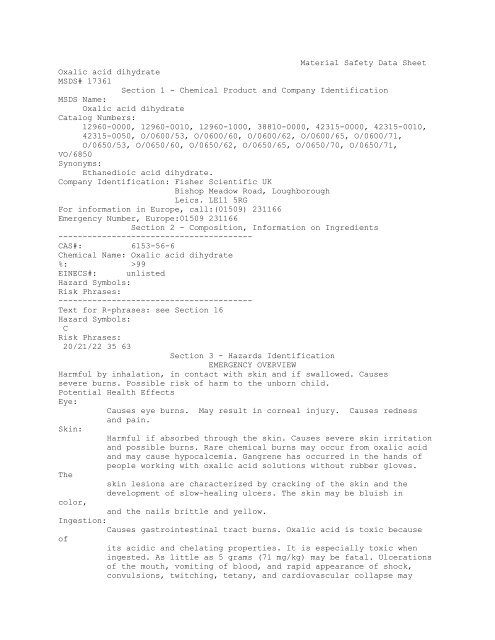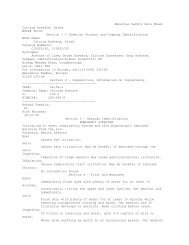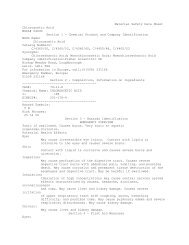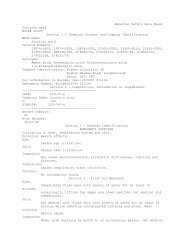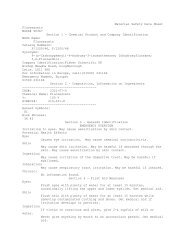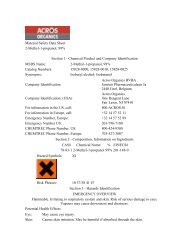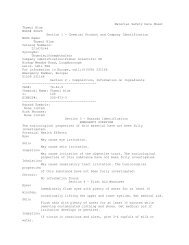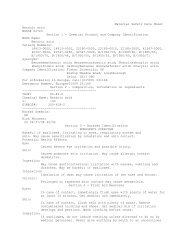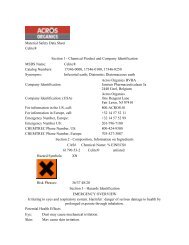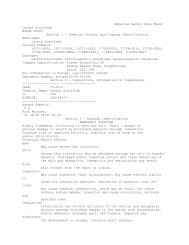Oxalic acid - Clayton State University
Oxalic acid - Clayton State University
Oxalic acid - Clayton State University
Create successful ePaper yourself
Turn your PDF publications into a flip-book with our unique Google optimized e-Paper software.
Material Safety Data Sheet<strong>Oxalic</strong> <strong>acid</strong> dihydrateMSDS# 17361Section 1 - Chemical Product and Company IdentificationMSDS Name:<strong>Oxalic</strong> <strong>acid</strong> dihydrateCatalog Numbers:12960-0000, 12960-0010, 12960-1000, 38810-0000, 42315-0000, 42315-0010,42315-0050, O/0600/53, O/0600/60, O/0600/62, O/0600/65, O/0600/71,O/0650/53, O/0650/60, O/0650/62, O/0650/65, O/0650/70, O/0650/71,VO/6850Synonyms:Ethanedioic <strong>acid</strong> dihydrate.Company Identification: Fisher Scientific UKBishop Meadow Road, LoughboroughLeics. LE11 5RGFor information in Europe, call:(01509) 231166Emergency Number, Europe:01509 231166Section 2 - Composition, Information on Ingredients----------------------------------------CAS#: 6153-56-6Chemical Name: <strong>Oxalic</strong> <strong>acid</strong> dihydrate%: >99EINECS#: unlistedHazard Symbols:Risk Phrases:----------------------------------------Text for R-phrases: see Section 16Hazard Symbols:CRisk Phrases:20/21/22 35 63Section 3 - Hazards IdentificationEMERGENCY OVERVIEWHarmful by inhalation, in contact with skin and if swallowed. Causessevere burns. Possible risk of harm to the unborn child.Potential Health EffectsEye:Causes eye burns. May result in corneal injury. Causes rednessand pain.Skin:Harmful if absorbed through the skin. Causes severe skin irritationand possible burns. Rare chemical burns may occur from oxalic <strong>acid</strong>and may cause hypocalcemia. Gangrene has occurred in the hands ofpeople working with oxalic <strong>acid</strong> solutions without rubber gloves.Theskin lesions are characterized by cracking of the skin and thedevelopment of slow-healing ulcers. The skin may be bluish incolor,and the nails brittle and yellow.Ingestion:Causes gastrointestinal tract burns. <strong>Oxalic</strong> <strong>acid</strong> is toxic becauseofits <strong>acid</strong>ic and chelating properties. It is especially toxic wheningested. As little as 5 grams (71 mg/kg) may be fatal. Ulcerationsof the mouth, vomiting of blood, and rapid appearance of shock,convulsions, twitching, tetany, and cardiovascular collapse may
occur following ingestion of oxalic <strong>acid</strong> or its soluble salts.<strong>Oxalic</strong> <strong>acid</strong> can bind calcium to form calcium oxalate which isinsoluble at physiological pH. Calcium oxalate thus formed mightprecipitate in the kidney tubules and the brain. Hypocalcemiasecondary to calcium oxalate formation might disturb the functionofthe heart and nerves.Inhalation:Causes chemical burns to the respiratory tract. Inhalation ofoxalic<strong>acid</strong> dust or vapor produces irritation of the respiratory tract,protein in the urine, nosebleed, ulceration of the mucousmembranes,headache, nervousness, cough, vomiting, emaciation, back pain (duetokidney injury), and weakness.Chronic:Inhalation of oxalic <strong>acid</strong> dust or mist over a long period of timemight result in weight loss and respiratory tract inflammation.Ratsadministered oxalic <strong>acid</strong> at 2.5 and 5% in the diet for 70 daysdeveloped depressed thyroid function and weight loss. A study ofrailroad car cleaners in Norway who were heavily exposed to oxalic<strong>acid</strong> solutions and vapors revealed a 53% prevalence of urolithiasis(the formation of urinary stones), compared to a rate of 12% amongunexposed workers from the same company.Section 4 - First Aid MeasuresEyes:In case of contact, immediately flush eyes with plenty of water forat least 15 minutes. Get medical aid immediately.Skin:In case of contact, immediately flush skin with plenty of water forat least 15 minutes while removing contaminated clothing and shoes.Get medical aid immediately. Wash clothing before reuse.Ingestion:If swallowed, do NOT induce vomiting. Get medical aid immediately.If victim is fully conscious, give a cupful of water. Never giveanything by mouth to an unconscious person.Inhalation:If inhaled, remove to fresh air. If not breathing, give artificialrespiration. If breathing is difficult, give oxygen. Get medicalaid.Notes to Physician:Treat symptomatically and supportively.Antidote:Intravenous administration of calcium gluconate or calcium chloridemay be required if hypocalcemia or hypocalcemic tetany occur.Section 5 - Fire Fighting MeasuresGeneral Information:As in any fire, wear a self-contained breathing apparatus inpressure-demand, MSHA/NIOSH (approved or equivalent), and fullprotective gear. During a fire, irritating and highly toxic gasesmay be generated by thermal decomposition or combustion. Use waterspray to keep fire-exposed containers cool.Extinguishing Media:Use water spray, dry chemical, carbon dioxide, or alcohol-resistantfoam.
Section 6 - Accidental Release MeasuresGeneral Information:Use proper personal protective equipment as indicated in Section 8.Spills/Leaks:Vacuum or sweep up material and place into a suitable disposalcontainer. Avoid runoff into storm sewers and ditches which lead towaterways. Clean up spills immediately, observing precautions intheProtective Equipment section. Avoid generating dusty conditions.Provide ventilation.Section 7 - Handling and StorageHandling:Wash thoroughly after handling. Minimize dust generation andaccumulation. Do not get in eyes, on skin, or on clothing. Do notingest or inhale. Discard contaminated shoes. Use only withadequateventilation.Storage:Keep container closed when not in use. Store in a cool, dry,well-ventilated area away from incompatible substances.Section 8 - Exposure Controls, Personal ProtectionEngineering Controls:Facilities storing or utilizing this material should be equippedwith an eyewash facility and a safety shower. Use adequate generalorlocal exhaust ventilation to keep airborne concentrations below thepermissible exposure limits.Exposure LimitsCAS# 144-62-7:United Kingdom, WEL - TWA: 1 mg/m3 TWAUnited Kingdom, WEL - STEL: 2 mg/m3 STELUnited <strong>State</strong>s OSHA: 1 mg/m3 TWABelgium - TWA: 1 mg/m3 TWABelgium - STEL: 2 mg/m3 STELFrance - VME: 1 mg/m3 VMEMalaysia: 1 mg/m3 TWANetherlands: 1 mg/m3 MACSpain: 1 mg/m3 VLA-EDCAS# 6153-56-6:Personal Protective EquipmentEyes:Wear appropriate protective eyeglasses or chemicalsafety goggles as described by OSHA's eye and faceprotection regulations in 29 CFR 1910.133 or EuropeanStandard EN166.Skin:Wear appropriate protective gloves to prevent skinexposure.Clothing:Wear appropriate protective clothing to prevent skinexposure.Respirators:Follow the OSHA respirator regulations found in 29CFR 1910.134 or European Standard EN 149. Use aNIOSH/MSHA or European Standard EN 149 approvedrespirator if exposure limits are exceeded or ifirritation or other symptoms are experienced.
Section 9 - Physical and Chemical PropertiesPhysical <strong>State</strong>:PowderColor:whiteOdor:odorlesspH:1.3 (0.1M soln)Vapor Pressure:.92 mm Hg @ 60 deg CViscosity:Not availableBoiling Point:Not applicable.Freezing/Melting Point: 101 deg C ( 213.80F)Autoignition Temperature: Not applicableFlash Point:Not applicable.Explosion Limits: Lower:Not availableExplosion Limits: Upper:Not availableDecomposition Temperature: Not availableSolubility in water: Moderately Soluble. 1g/7mlSpecific Gravity/Density: 1.653 @ 18.5CMolecular Formula:C2H2O4.2H2OMolecular Weight: 126.04Section 10 - Stability and ReactivityChemical Stability:Stable under normal temperatures and pressures.Conditions to Avoid:Dust generation, excess heat.Incompatibilities with Other MaterialsStrong oxidizing agents, mercury, hypochlorite, silver, strongalkalies, chlorites, furfuryl alcohol.Hazardous Decomposition ProductsCarbon monoxide, carbon dioxide, formic <strong>acid</strong>.Hazardous PolymerizationHas not been reported.Section 11 - Toxicological InformationRTECS#:CAS# 144-62-7: RO2450000CAS# 6153-56-6: None listedLD50/LC50:RTECS: CAS# 144-62-7: Draize test, rabbit, eye: 250 ug/24HSevere; Draize test, rabbit, skin: 500 mg/24H Mild; Oral,rat: LD50 = 7500 mg/kg;.RTECS: CAS# 6153-56-6:.Other:Carcinogenicity:<strong>Oxalic</strong> <strong>acid</strong>, anhydrous -Not listed as a carcinogen by ACGIH, IARC, NTP, or CA Prop 65.<strong>Oxalic</strong> <strong>acid</strong> dihydrate -Not listed as a carcinogen by ACGIH, IARC, NTP, or CA Prop 65.Other:See actual entry in RTECS for complete information.Section 12 - Ecological InformationEcotoxicity:Fish: Bluegill/Sunfish: LC50 = 4000 mg/L; 24 Hr.; StaticConditionsFish: Mosquito Fish: LC50 = 1350 mg/L; 24 Hr.; StaticConditionsSection 13 - Disposal ConsiderationsDispose of in a manner consistent with federal, state, and local regulations.Section 14 - Transport InformationIATAShipping Name:CORROSIVE SOLIDS, TOXIC, N.O.S.
possibility of such damages.--------------------------------------------------------------------------------


